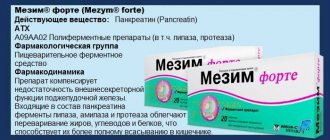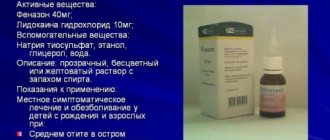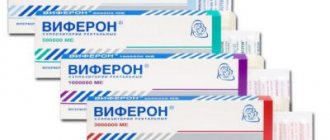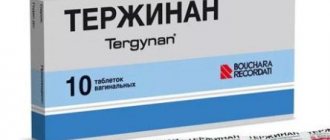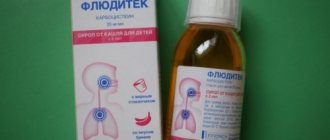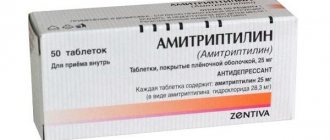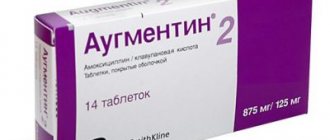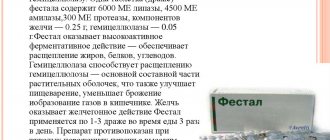Has restrictions during pregnancy
Prohibited during breastfeeding
Prohibited for children
Has restrictions for older people
Has limitations for liver problems
Has limitations for kidney problems
Muscle relaxants are widely used to relieve spasms, increase the mobility of affected muscles and relieve pain symptoms. Mydocalm is an effective and frequently prescribed remedy in this group, which has a rapid effect and helps reduce muscle tone. However, in some cases it is necessary to use inexpensive analogues of Mydocalm, which no less quickly have the desired effect and are not inferior in their characteristics to expensive equivalents.
The main active ingredient in Mydocalm is tolperisone, which acts as a centrally acting muscle relaxant, helps to relieve the manifestations of diseases of the musculoskeletal system, improves the functioning of the nervous system and copes with inflammatory diseases. The advantage of the drug is that it is available in two forms: tablets and ampoules.
Mechanism of action of Mydocalm
Its bioavailability is 15-20%. The drug actively interacts with nervous tissue, reaching high concentrations in the spinal cord and brain, as well as in the peripheral nervous system. Mydocalm reduces the excitability of motor neurons and inhibits the activity of sodium channels, increasing blood circulation.
The medication is most often prescribed for the following pathologies:
- muscle spasms;
- arthrosis of large joints;
- postoperative period in traumatology.
Contraindications to the use of this drug are:
- drowsiness;
- headache and pain in limbs;
- noise in ears;
- heat;
- irritability.
Pharmacodynamics and pharmacokinetics
Mydocalm prevents the destruction of cell membranes and provides a pronounced membrane-stabilizing effect. The mechanism of this action is based on inhibition of lipid peroxidation processes and modulation of the activity of membrane-bound enzymes.
In addition, the drug acts as a local anesthetic, and also inhibits the conduction of nerve impulses in primary afferent (from the Latin “afferens” - bringing) nerve fibers and motor neurons - nerve cells responsible for transmitting information to effectors (usually muscles) from the central nervous system.
The latter leads to blocking of polysynaptic and monosynaptic reflexes of the spinal cord.
It is considered probable that Mydocalm has the ability to secondarily inhibit the processes of mediator release. This is ensured by inhibiting the flow of calcium ions (Ca2+) to the places of functional contact between neurons, in which information is transmitted from one cell to another (or, in other words, to synapses).
In the brain stem, Mydocalm eliminates the facilitation of the spread of excitation along the reticulospinal tract (reticulospinal tract).
Promotes increased peripheral blood flow (regardless of the influence of the central nervous system), reduces pathologically increased muscle tone, eliminates muscle rigidity, reduces the severity of pain in the muscles, eliminates or reduces the severity of disorders of voluntary active movements.
This effect is ensured by the ability of tolperisone to have a mild antispasmodic and adrenergic blocking effect.
Thanks to the activity of tolperisone, Mydocalm also reduces the toxicity of the indole alkaloid strychnine , helps suppress the increase in reflex excitability caused by it and has vasodilating properties.
Some evidence suggests that the drug has a selective inhibitory effect on the caudal (from the Latin “cauda” - tail, caudal) part of the spinal cord formation going to the thalamus in the rostral direction (that is, to the cortex). As a result, the severity of spastic phenomena decreases.
According to Wikipedia, tolperisone, which is part of Mydocalm, also causes a central H-anticholinergic effect.
The action of N-cholinergic drugs is based on the fact that when they enter the body, they act on nicotinic receptors, localized mainly in postsynaptic membranes located in skeletal muscle synapses, ganglia of the autonomic nervous system, tissues forming the adrenal medulla, as well as in tissues sinocarotid zone.
By interacting with receptors, N-anticholinergics and, in particular, tolperisone, block their ability to perceive acetylcholine , as a result of which the nerve impulse is not transmitted through the blocked synapse. Thus, the neurotransmitter is released, but the blocked receptors of the postsynaptic membrane are no longer able to respond to the stimulus.
Tolperisone does not have a pronounced effect on the peripheral parts of the nervous system.
After taking the Mydocalm tablet, tolperisone is well absorbed from the gastrointestinal tract. The maximum concentration of the substance is observed after approximately half an hour to an hour. Its biological activity is about 20%.
Tolperisone undergoes intensive biotransformation in the tissues of the liver and kidneys. The substance is excreted from the body by the kidneys in the form of metabolic end products (more than 99%), the pharmacological activity of which is unknown.
Characteristics of the drug
"Mydocalm" is a medicine that helps relieve pain in the muscle area. It is used to relieve pain in skeletal muscles only. By consuming Mydocalm, an inhibitory effect occurs in the human body, excitability decreases, and pain decreases. "Mydocalm" is an anesthetic drug that acts as a local anesthetic.
It is applied for:
- Vasodilation.
- Reducing muscle tension.
- Improves lymphatic blood flow.
- Treatments for Raynaud's disease.
- Elimination of trophic ulcers.
- Decreased tone.
- Treatment of muscular dystonia.
- Elimination of spastic paralysis.
Action of the medicine
The active ingredient is tolperisone. This substance is used to treat diseases of the central nervous system, increased tone and spasms.
The drug takes effect thirty minutes after administration. The effect may be earlier, but it is after half an hour that the maximum level of con is observed in the blood.
The drug is completely safe. There is no sedative effect after it. "Mydocalm" is not used in cases of hypersensitivity or intolerance to the active ingredients. The tablets should not be used by children under one year of age. The drug in the form of injection ampoules is prescribed to children at least three months old.
Contraindications:
- Muscular hypotonia.
- Myasthenic syndrome.
- Myasthenia.
- The use of the drug is prohibited for people who are allergic to lidocaine.
Use by pregnant women is a controversial issue. No studies have been conducted on this matter, but if necessary, doctors prescribe Mydocalm in the first twelve weeks of pregnancy. Analogues of the drug are prohibited during the lactation period and pregnancy.
How to use
Before using the drug, you should read the instructions. The brief instructions for Mydocalm (tablets) state that the tablets are taken simultaneously with the process of eating. People over eighteen years of age are prescribed a dosage of 450 mg.
It is divided into three doses and drunk throughout the day. For convenience, the tablet is ground into a powder and added to food. The course of treatment begins with a dose of 50 mg, then the dose is gradually increased to 450 mg.
"Mydocalm-Richter" (injections) is injected into a muscle or vein. An injection into a vein should not exceed a dosage of 200 mg of the drug. This amount is divided into two doses. For injection into a muscle you need 100 mg of the drug. Along with Mydocalm (injections), niflumic acid is used.
Children's dosage:
- Up to seven years – no more than 5 mg per kilogram of child’s weight.
- From seven to fifteen – from two to four mg of the drug per kilogram of the child’s weight.
Analogues of the drug
"Mydocalm" is a popular drug. It is preferred by more than twenty percent of the population. But few people know that the price of Mydocalm varies from 200 to 1000 rubles, so it is more advisable to purchase drugs that are cheaper, but have similar properties and indications to Mydocalm. There are positive reviews about the product, praising its effectiveness and quick results.
Analogs of Mydocalm are sold in all pharmacies in the Russian Federation and Ukraine. Their cost ranges from 200 to 500 rubles, depending on the company and country of manufacture, components, and release form.
"Mydocalm" is found in the form of ampoules for injections and tablets. The tablets are called Mydocalm, and the injections are called Mydocalm-Richter. All generics have the same indications, but completely different side effects. No one can guarantee that a Mydocalm substitute will be better than its analogue. But despite this, people do not stop purchasing substitutes for this pharmacological “miracle”.
On the pharmacological market you can buy cheap analogues of mydocalm, but no less effective. Medicines can be roughly divided into two groups. The first includes drugs that are an exact copy in component composition, the second includes drugs with other active substances in the composition, but with a similar therapeutic effect as mydocalm.
How to replace mydocalm? The drugs listed below are analogues of the drug Mydocalm. Analogues mean drugs that have the same international nonproprietary name or ATC code. To replace the drug prescribed to you with an analogue, be sure to consult your doctor!
- Baclofen
- Miolastan
- Miorix
- Myoflex
- Muskomed
- Sirdalud
- Tizalud
- Tizanidine
- Tolperil
- Miaxil
- Midostad
- Tolperil
Toperisone. Popular due to low cost. Release form: capsules and tablets. It is used to eliminate and treat radiculitis, hernias, back injuries, and spasms. Not recommended for use by children under one year of age.
It is prohibited to use during the lactation period. A side effect is the occurrence of an allergic reaction to the use of the drug.
"Sirdalud". Relieves chronic spasticity, helps with acute spasms. Take once a day according to instructions. The dose cannot be increased. The increased dosage is prescribed by the doctor based on the patient’s health condition. Release form: tablets. Used to relieve pain after surgery. Contraindications:
- Kidney failure.
- Liver failure.
- Pregnancy.
- Lactation period.
If we compare Midakalm and Sirdalud, then the second one is better in terms of effectiveness. This drug can act all day, but Midakalm has to be taken several times a day. Both drugs have the same indications for use. But Midakalm has more extensive side effects and Sirdalud is considered an improved analogue of the first.
"Miolgin." Properties of the product:
- Painkiller.
- Antipyretic.
The composition contains paracetamol, which brings down the temperature. Release form: capsules. Used for headaches, neurological disorders, sprains.
Doctors and pharmacists do not recommend taking the drug to minor children. It is prescribed to this category of the population in exceptional cases. Side effects:
- Dizziness.
- Sleep disturbance.
- Allergy.
- Vomit.
- Nausea.
Tizalud (Russia). The active substance tizanidine is similar in properties to tolperisone. Relieves muscle spasms in diseases of the spine and spinal cord, convulsions, and normalizes cerebral circulation. Price per pack of tablets: 30 pcs. 4 mg - 205 rubles, 2 mg - 145 rubles.
Tizanil (Russia). The active ingredient is tizanidine. The drug relieves spasms of skeletal muscles and is a pronounced analgesic. Available in a package of 30 pieces containing 2 mg tizanidine - price 160 rubles. or 20 pcs. with 4 mg in the composition at a price of 224 rubles.
Tizanidin Teva (Israel). The main component in the composition is tizanidine. According to doctors, the medicine has high bioavailability, i.e. ability to assimilate. An effective medicine when the dosage and dosage regimen are correctly selected by the doctor.
Noteworthy is the relatively small list of contraindications and possible complications. The low cost compared to other similar drugs characterizes the drug as one of the best analogues. A package of 30 pieces of 2 mg costs 129 rubles.
Baklosan (Russia). The active ingredient is baclofen. In terms of its therapeutic effects, it is similar to mydocalm and an absolute analogue of baclofen described above in paragraph 6, the characteristics of which completely coincide. The cost of a pack is 50 pieces. 10 mg - 280 rub.
All analogues listed in the list have a number of serious contraindications, most of which differ from mydocalm. Replacing drugs with cheaper ones, as well as a treatment regimen and dosage, can only be prescribed by the attending physician, taking into account the characteristics of the course of the disease and the patient’s condition.
Indications for the use of Mydocalm, what it treats and what the drug helps with
Indications for the use of Mydocalm are:
- pathologically increased muscle tone and spasms of skeletal (striated) muscle tissue, which are a consequence of organic lesions of the central nervous system, including multiple sclerosis , encephalomyelitis , cerebral stroke , etc.;
- myogenic contractures, increased muscle tone and spasticity caused by diseases of the musculoskeletal system (for example, lumbago with sciatica , spondylosis , arthrosis affecting large joints , cervical syndrome , etc.);
- non-inflammatory diseases of the brain accompanied by disorders of muscle tone (for example, cerebral palsy );
- cholelithiasis;
- severe pain syndrome, observed against the background of the development of hemorrhoids;
- menstrual pain syndrome;
- the threat of spontaneous abortion due to increased tone of the uterine muscle structures;
- renal colic.
The use of the drug Mydocalm is indicated:
- during the period of rehabilitation therapy after orthopedic, surgical or traumatological operations (this is due to the ability of tolperisone to have a beneficial effect on the degree of stretching of muscle fibers);
- as part of complex therapy for obliterating vascular lesions (according to the annotation, the drug is effective for diabetic angiopathy , Raynaud's syndrome , thromboangiitis obliterans , etc.);
- for the symptomatic treatment of muscle spasm in adult patients who have had a stroke ;
- for pathologies caused by disorders of vascular innervation (severe gait disturbances or pathological cyanosis of the extremities).
Why are muscle relaxants prescribed for osteochondrosis?
Like other centrally acting muscle relaxants, Mydocalm can be prescribed for osteochondrosis .
The pain syndrome that develops with osteochondrosis provokes a compensatory spasm of the deep layers of the back muscles. And this, in turn, causes myofixation of the spinal column and limitation of the mobility of the spinal motion segments.
The consequence of such a muscular-tonic imbalance is a worsening of the course of the disease and a decrease in the therapeutic effectiveness of all measures taken.
Muscle relaxants for osteochondrosis are prescribed to eliminate this imbalance. Drugs from this pharmacotherapeutic group:
- have a sedative effect;
- relieve pain symptoms;
- suppress spinal reflexes;
- relieve muscle tension.
Thanks to these qualities, muscle relaxants increase the effectiveness of other therapeutic interventions: massage, physical therapy, traction therapy, etc. They also have the ability to potentiate the effect of blockades, other painkillers and physiotherapeutic procedures.
At the same time, muscle relaxants have a number of contraindications for use and can provoke undesirable side effects (in particular, with long-term treatment in patients, the function of the hepatobiliary system is often impaired and body weight increases).
However, unlike chondroprotective drugs, they actually improve the condition of patients suffering from osteochondrosis (which is achieved by removing pathological myofixation) and increase the effectiveness of conservative therapy.
To treat osteochondrosis, it is recommended to take muscle relaxants in very short courses. And yet, keeping in mind the abundance of side effects, medical practitioners very carefully include these drugs in the treatment regimens of their patients.
Sirdalud or Mydocalm - which is better?
If the question arises of what to replace Mydocalm with, then the most popular analogue is the Swiss drug Sirdalud.
This medication is similar to Mydocalm not in the active substance, but in the principle of its effect on the body.
The active component of Sirdalud is tizanidine. The medicine is sold in tablet form, one tablet contains 2 or 4 mg of tizanidine.
The Swiss analogue has a significant advantage over the original drug. Tizanidine, once in the human body, is not absorbed from the tablet immediately, but gradually, so that the medicine acts evenly throughout the day.
The main effect of tizanidine is inhibition of the transmission of nervous excitation, leading to a weakening of muscle tension. Sirdalud is not only a muscle relaxant, but also an analgesic of moderate activity. The medicine begins to act an hour after administration. The spent active substance leaves the body in 3–4 hours.
Sirdalud is prescribed for the following pathologies:
- osteochondrosis and other diseases of the spinal column, complicated by painful spasms of the spinal muscles;
- pathological changes in bone and joint tissue;
- multiple sclerosis;
- stroke;
- convulsive states of any origin;
- cerebral palsy;
- some diseases of the spinal cord;
- negative consequences of spinal surgery.
It is forbidden to take the medication if:
- liver dysfunction;
- intolerance to the active substance;
- treatment with antidepressants, fluoroquinolone antibiotics, CYP1A2 inhibitors;
- feeding a child with breast milk.
The effect of a muscle relaxant on a developing embryo in the womb has not been studied. Therefore, it is not advisable to take the medicine during pregnancy. Doctors prescribe Sirdalud to pregnant patients only as a last resort, when the need for recovery is more important than the likely risk to the fetus.
Sirdalud gives more side effects than Mydocalm. When taking Swiss medication, the following unpleasant phenomena are possible:
- weakness, powerlessness;
- liver dysfunction;
- nausea;
- drying of the oral mucosa;
- disruption of the digestive tract;
- decreased blood pressure;
- slowing heart rate.
Taking Sirdalud can provoke serious pathological changes in the functioning of the liver. Therefore, during therapy, it is recommended to periodically undergo laboratory tests to check the condition of the liver tissue. The drug also has a negative effect on concentration.
Overdose is accompanied by the following symptoms:
- significant decrease in blood pressure;
- nausea;
- weakness, malaise;
- dizziness;
- respiratory dysfunction.
In case of severe overdose, the patient may fall into a coma.
- Calcium is an important substance for the human body;
- Cheap analogue of Xarelto - list of medications;
- - analogues of Lamisil.
Contraindications
Contraindications to the use of Mydocalm tablets:
- age up to one year;
- persistent pathological weakness and rapid fatigue of skeletal muscle tissue ( myasthenia gravis );
- increased individual sensitivity to any of the components of the drug.
Before taking Mydocalm tablets for osteochondrosis , you should also take into account that all muscle relaxants are contraindicated in patients:
- currently or with a history of increased seizure activity;
- those suffering from Parkinson's disease ;
- suffering from chronic renal and/or liver failure ;
- those suffering from epileptic seizures ;
- having a history of drug addiction;
- with a history of acute psychosis .
TOP 10 cheaper analogues
The price of Mydocalm ranges from 250 to 550 rubles; cheaper analogues of the drug include the following drugs:
- Tolperisone - from 140 to 200 rubles;
- Miolgin - from 200 to 230 rubles;
- Sirdalud - from 220 rubles to 360 rubles;
- Baclofen – from 280 to 380 rubles;
- Tolperil - from 140 to 200 rubles;
- Tizanidine – from 110 to 160 rubles;
- Tolperisone-OBL – from 140 to 190 rubles;
- Amelotex - from 120 to 330 rubles;
- Arthrozan - from 150 to 350 rubles;
- Dexamethasone - from 50 to 100 rubles.
Previous MedicinesKaripain - composition and forms of release of the drug, instructions for use Next
MedicinesHyaluronic acid for joints - use, review of drugs, reviews
Side effects of Mydocalm
The safety profile of tablets containing tolperisone is based on data from more than 12 thousand patients.
Statistics show that most often after taking tolperisone drugs, adverse reactions occurred such as systemic disorders, disorders of the skin and subcutaneous tissue, as well as nervous disorders and digestive disorders.
Post-marketing observations have shown that in 50-60% of cases, side effects associated with taking tolperisone drugs are reactions of increased individual sensitivity.
Most of these reactions do not threaten the patient’s health, do not require specific treatment and go away on their own.
Reactions of increased individual sensitivity, which are life-threatening, have been recorded in isolated cases.
In accordance with the MedDRA Medical Dictionary of Regulatory Activities, all side effects that occur during treatment with a particular drug are classified into frequent, infrequent, rare and very rare.
Infrequent (occur no more than once in a thousand cases) side effects that occur after taking Mydocalm include:
- eating and metabolic disorders, which are expressed in the form of anorexia ;
- insomnia and sleep disorders;
- headache , dizziness , increased drowsiness ;
- arterial hypotension;
- feeling of discomfort in the abdomen, diarrhea , increased dryness of the mucous membrane in the mouth, dyspeptic symptoms, nausea;
- muscle weakness, pain in the limbs, muscle pain;
- asthenia , feeling of general discomfort, increased fatigue.
Rare adverse reactions occurring more often than once in a thousand cases, but less than once in ten thousand cases:
- anaphylactic reaction;
- decreased activity, depressive states;
- disturbances of attention, tremor , increased convulsive activity, hypoesthesia (decreased sensitivity to the effects of stimuli), paresthesia , increased drowsiness;
- tinnitus , vertigo ;
- angina pectoris , tachycardia , rapid heartbeat, decreased blood pressure;
- hyperemia of the skin;
- difficulty breathing, nosebleeds, rapid breathing;
- pain in the epigastric region, constipation , flatulence , vomiting;
- mild forms of liver dysfunction;
- allergic dermatitis , increased sweating, itching, urticaria , skin rashes;
- feeling of discomfort in the limbs;
- enuresis , proteinuria ;
- feeling of intoxication, feeling of heat, irritability, increased thirst ;
- increased bilirubin levels in the blood, changes in the activity of liver enzymes, decreased platelet , leukocytosis .
Extremely rarely (no more often than in one in ten thousand cases) the following may occur:
- anemia , enlarged lymph nodes ( lymphadenopathy );
- anaphylaxis (anaphylactic shock);
- polydipsia;
- confusion;
- bradycardia;
- osteopenia;
- feeling of discomfort in the chest;
- increase in creatinine in the blood.
Inexpensive substitutes in ampoules
In addition to the tablet form of muscle relaxants, there are cheap analogues in ampoules, which allows the medicine to be administered by injection. The advantage of these analogues is the quickly achieved therapeutic effect.
Ambien
Ambene is a combination drug whose action is aimed at relieving inflammation, fever and providing an analgesic effect. The medicine is quickly absorbed into the bloodstream after administration. Ambene is indicated for use if the patient has:
- Arthritis.
- Pain syndromes caused by degenerative diseases of the spine.
- Neuralgia.
Indications for use
The medication is used no more than three times a week, the injection is given daily or every other day. The drug must be administered intramuscularly and slowly. In this case, the patient should be in a horizontal position. The temperature of the administered medication should correspond to the patient's body temperature. If repeated treatment is necessary, an interval of several weeks must be observed between therapeutic courses.
It is possible that some side effects may occur from the nervous and digestive systems, which may include:
- Stomach pain.
- Lack of appetite.
- Nausea and vomiting.
- Dizziness.
- Sleep disturbance.
- Psychosis.
Amelotex
Ampoules are not the only form of this drug: it is also available in the form of gel, tablets and rectal suppositories. The Amelotex solution contained in ampoules is a light yellow liquid containing meloxicam. The medication has an analgesic effect, helps reduce fever and effectively reduces the area of inflammation. Amelotex is administered intramuscularly once a day. The maximum permissible daily dose is 15 mg.
The medicine is indicated for use in the following cases:
- arthritis;
- Bekhterev's disease;
- inflammation of the joints, which are accompanied by pain;
- osteoarthritis.
Indications for administration of Amelotex
A course of Amelotex injections is strictly contraindicated for the following problems:
- any bleeding;
- stomach ulcer;
- bronchial asthma;
- pregnancy.
Arthrozan
The medication is a non-steroidal drug that has an anti-inflammatory effect. Artrosan injections have a short-term effect in treating the symptoms of arthritis, spondylitis, osteoarthritis, relieve pain in the lower back and shoulders, and also help with diseases of the muscular system. The daily dose is 15 mg, and the therapeutic effect after its administration occurs within an hour. The drug should not be used if the patient has:
- Stomach ulcer.
- Bleeding.
- Ulcerative colitis.
Benefits of Artrosan
Artrosan should be prescribed with extreme caution to people with gastrointestinal diseases, congestive heart failure, coronary heart disease, diabetes mellitus and alcoholism. The drug is contraindicated for children, pregnant and breastfeeding women.
Dexamethasone
The use of Dexamethasone in ampoules is most often due to the impossibility of using the tablet form. The drug is prescribed if the patient has:
- severe bronchospasm;
- anaphylactic shock;
- cerebral edema;
- severe dermatosis;
- arthritis;
- blood diseases.
Pharmacological features of Dexamethasone
The introduction of Dexamethasone into a joint is prohibited in the presence of severe bone deformation, instability and bone fractures. The dose should be reduced if the patient suffers from infectious, gastrointestinal and cardiovascular diseases. Use during pregnancy is acceptable if treatment is agreed upon with a doctor.
The average dose of Dexamethasone is up to 6 mg, a single injection every three days. In case of overdose, an increase in blood pressure, the appearance of edema, and impaired consciousness are observed. Undesirable effects of the drug include metabolic failure and heart failure.
Mesipol
Mesipol is a solution for deep intramuscular injection. This is a non-steroidal drug that actively fights inflammation, protects and renews connective tissue.
Mesipol injections can be administered only for the first two days after the start of treatment.
After this period, the patient must be transferred to treatment with a tablet form of the medication. The daily dose is no more than 7-15 mg per day. The drug is indicated for the treatment of arthritis and is actively used to treat ankylosing spondylitis.
Neurobion
The medication contains a complex of useful substances (vitamins and microelements), which not only replenishes vitamin deficiencies in diseases, but also stimulates the launch of natural mechanisms for the restoration of nerve tissue. Indications for taking Neurobion are neurological diseases:
- neuritis;
- neuralgia;
- neuropathic pain;
- diseases of the spine.
Dosage of the drug
Neurobion is not suitable for all age groups of patients: children are not allowed to take the drug. You cannot be treated with Neurobion during pregnancy and breastfeeding.
Mydocalm tablets, instructions for use (Method and dosage regimen)
The medicine is intended for oral administration. It is optimal to take it immediately after a meal, without chewing and with a small amount of liquid.
Adults are recommended to start treatment with the drug with a dose of 100-150 mg per day, divided into 2 or 3 doses. Further treatment involves a gradual increase in a single dose to 150 mg. The frequency of doses remains unchanged (2-3 per day).
Typically, the dosage is selected depending on muscle tone, pain intensity, the presence of contraindications in the patient and concomitant chronic diseases.
Based on this data, the doctor also determines how many days to take the pills. The duration of the therapeutic course usually does not exceed ten days.
According to the instructions for use of Mydocalm, children under fourteen years of age are allowed to be prescribed tablets containing 50 mg of tolperisone.
Children aged from one to six years are given the drug Mydocalm in a dose equal to 5 mg of tolperisone per kilogram of the child’s body weight per day. The indicated dose is divided into 3 doses during the day. In cases where the child is not able to swallow a whole tablet, it is first crushed.
For children from seven to fourteen years of age, the instructions for use of Mydocalm recommend prescribing the drug in a daily dose equal to 2 to 4 mg of tolperisone per kilogram of the child’s body weight. The multiplicity of techniques is 3.
After oral administration, the drug begins to act after approximately forty minutes. The duration of action varies from 4 to 6 hours (it depends on how well the renal blood filtration system is functioning).
Treatment of certain diseases is supplemented with a complex of physiotherapeutic measures, gymnastics, massage courses, rubbing ointments, etc.
Prices for the drug and its main analogues, average in Russia
The price of Mydocalm, its domestic and foreign analogues may vary depending on the pharmacy and region.
| Drug name | Release form | Average price (in rubles) |
| Mydocalm | Tablets and ampoules | 382-301 |
| Miolgin | Pills | 310-343 |
| Sirdalud | Pills | 285-294 |
| Dexamethasole | Ampoules | 203-223 |
| Neurobion | Ampoules | 277-280 |
| Baklosan | Pills | 280-285 |
| Baclofen | Pills | 266-490 |
| Tizalud | Pills | 159-220 |
| Tizanidine | Pills | 132-190 |
| Ambien | Pills | 1700-2200 |
| Amelotex | Ampoules | 119-224 |
| Arthrozan | Ampoules | From 149 |
| Mesipol | Ampoules | From 212 |
Overdose
There are no data on Mydocalm overdose. The drug is characterized as non-toxic and having a wide range of therapeutic effects. In the literature, there are descriptions of oral administration of a dose of tolperisone equal to 600 mg in pediatric patients. And without any serious toxic manifestations.
Oral intake by children of a dose equal to 300-600 mg, in some cases, may be accompanied by an increase in irritability.
The drug does not have a specific antidote. If the dose recommended by the instructions is exceeded and any undesirable symptoms appear against this background, the patient is recommended to undergo gastric lavage and then symptomatic and supportive therapy.
Interaction
There are no data on interactions with other drugs that would limit the use of Mydocalm.
Despite the fact that tolperisone has the ability to act on the central nervous system, it does not provoke a sedative effect. For this reason, it can be combined with sedatives, sleeping pills and drugs containing alcohol.
Tolperisone has no effect on the effect of alcohol on the central nervous system. The activity of the substance is enhanced by:
- preparations for general anesthesia;
- peripherally acting muscle relaxants;
- psychotropic drugs;
- clonidine (a substance that has a hypotensive effect).
Movalis, Mydocalm and Milgamma (drug compatibility)
Milgamma , Movalis and Mydocalm are well-combined drugs. Therefore, they are often prescribed as part of complex therapy for patients with pathologies of the musculoskeletal system.
Patients with this type of disease in the vast majority of cases suffer from severe joint pain. The use of Movalis and Mydocalm together can reduce the severity of pain, relieve spasms and muscle hypertonicity. In addition, Movalis is characterized by a neutral effect in relation to cartilage tissue.
The drug Milgamma belongs to the pharmacological group B vitamins and is used as a general tonic. It has a pronounced metabolic, analgesic and neuroprotective effect.
vitamins belonging to group B have a beneficial effect on inflammatory and degenerative diseases that affect the nervous system and musculoskeletal system.
The regimen for taking Movalis-Milgamma-Mydocalm is determined by the attending physician.
Baclofen
A muscle relaxant with a central mechanism of action of a group of chlorophenylbutyric acid derivatives. Reduces increased skeletal muscle tone, mainly caused by damage to the spinal cord. Baclofen inhibits skin reflexes and muscle tone, and slightly reduces the amplitude of tendon reflexes.
The pharmacological effect of the drug may be due to hyperpolarization of ascending nerve fibers and inhibition of both monosynaptic and polysynaptic reflexes at the level of the spinal cord. Baclofen does not affect neuromuscular transmission processes. Since the use of baclofen in high doses can cause depression of central nervous system function, the effect of the drug on centers located supraspinally cannot be ruled out.
After oral administration, baclofen is quickly and completely absorbed into the gastrointestinal tract. Therapeutic concentration is 80–395 ng/ml. The maximum concentration in blood plasma (500–600 ng/ml) is achieved 2–3 hours after oral administration. The concentration is then maintained at 200 ng/ml for 8 hours.
Baclofen penetrates into many tissues, but only a small part of it passes through the BBB. Baclofen penetrates the placental barrier. A minimal amount of the drug passes into breast milk. Baclofen is approximately 30% bound to plasma proteins. About 15% of the administered dose of the drug is metabolized in the liver through deamination.
T½ is 2.5–4 hours. From 70 to 80% of baclofen is excreted in the urine unchanged or in the form of metabolites, the rest is excreted in feces. The drug is almost completely eliminated from the body within 72 hours after administration.
Directions for use and dosage
Inside (better during meals). Recommended doses for adults. The initial dose is 5 mg 3 times a day for 3 days, then on every 4th day of treatment the single dose is increased by 5 mg (dose frequency - 3 times a day) until the optimal dose is reached at 20-25 mg 3 times a day .
Recommended dosage regimen:
- Days 1–3 - 5 mg (1/2 tablet of 10 mg) 3 times a day;
- 4–6 days - 10 mg (1 tablet) 3 times a day;
- 7–9 days - 15 mg (1 1/2 tablets of 10 mg) 3 times a day;
- Days 10–12 - 20 mg (2 tablets of 10 mg) 3 times a day.
In most patients, a therapeutic effect is observed after using the drug at a dose of 30–75 mg/day. If necessary, the dose can be gradually increased. For patients requiring higher doses (daily dose 75–100 mg), it is advisable to prescribe tablets containing 25 mg of baclofen.
The daily dose of the drug should not exceed 100 mg. The duration of treatment depends on the clinical condition of the patient. The drug should not be interrupted suddenly, since in this case hallucinations may occur and spastic conditions may worsen. If it is necessary to discontinue baclofen, its dose is reduced gradually.
In elderly patients, the dose of the drug should be increased with extreme caution, since their risk of adverse reactions is higher.
Recommended doses for children: The usual daily dose of the drug is 0.75–2 mg/kg body weight. Treatment should begin with a dose of 5 mg, taken 2 times a day. Children from 12 months to 2 years are prescribed 10-20 mg/day, 2-6 years - 20-30 mg/day, 6-10 years - 30-60 mg/day.
For children over 10 years of age, the maximum daily dose is 2.5 mg/kg body weight. If necessary, the dose can be carefully increased every 3 days until an optimal therapeutic effect is obtained.
Recommended doses for patients with impaired renal function: For patients with impaired renal function, as well as patients on hemodialysis, the dose of the drug is reduced to 5 mg/day.
Side effects
More often occur after a sudden increase in dose, taking the drug in high doses, or in elderly patients. In most cases, after reducing the dose of the drug, they weaken and disappear. If serious side effects occur, treatment should be stopped.
From the side of the central nervous system: 10–63% - drowsiness; 5–15% - vertigo; 4–12% - nausea; 1–11% - confusion; 4–8% – headache; 2–7% - insomnia; 2–4% - weakness and increased fatigue; rarely - euphoria, increased excitability, depression, hallucinations, paresthesia, muscle pain and weakness, ataxia, dry mouth, exhaustion, tremor, asthenia, depression of the respiratory and cardiovascular system, disorientation in space, dizziness, vomiting, adaptation disorder , night terrors, nystagmus, decreased seizure threshold and development of a convulsive attack (especially in patients with epilepsy).
From the cardiovascular system: 0–9% - arterial hypotension; rarely - dyspnea, tachycardia, chest pain, fainting. From the digestive system: 2–6% - constipation; rarely - anorexia, dysgeusia, abdominal pain, diarrhea, positive test results for the presence of occult blood in the stool.
From the genitourinary system: 2–6% - frequent urge to urinate. Other: visual and taste disturbances, rash, itching, ankle swelling, excessive sweating, weight gain, feeling of nasal congestion, changes in plasma glucose levels and other biochemical parameters. In some patients, exacerbation of spastic conditions was noted (paradoxical reaction to the drug).
special instructions
During treatment with Baclofen, exacerbation of psychotic syndromes, schizophrenia, seizures and the occurrence of a state of disorientation in time and space are possible. In such patients, the drug must be prescribed carefully and under close medical supervision.
The dose of the drug must be reduced gradually over 1–2 weeks, since after sudden discontinuation of treatment, anxiety and confusion, hallucinations, psychosis, mania, paranoia and convulsions may develop, and the severity of spastic symptoms may increase.
Prescribe Baclofen with caution to patients with impaired renal or liver function (the dose is reduced depending on the degree of impairment); elderly patients (there is an increased risk of adverse reactions); patients with epilepsy (careful clinical and EEG monitoring is required, since cases of decreased effectiveness of anticonvulsant treatment and changes in the EEG diagram have been identified).
Patients in whom maintaining an upright body position, balance, or increasing motor amplitude depends on muscle tone; patients receiving antihypertensive treatment (possibility of hypotension); patients with stroke, respiratory dysfunction; patients with increased tone of the bladder sphincter (possible urinary retention).
When treated with Baclofen, the concentration of ALT, ALP or glucose in the blood serum may increase. Constant laboratory monitoring is recommended, especially in patients with impaired liver function and patients with diabetes mellitus.
Baclofen penetrates the placental barrier. Due to the lack of data regarding the use of the drug during pregnancy, Baclofen should be taken only if absolutely necessary. Before prescribing Baclofen, the potential benefits and possible risks for both the mother and the fetus must be carefully weighed. Baclofen is excreted in milk, so breastfeeding is not recommended while taking the drug.
When taking the drug, symptoms may be noted due to its sedative effect and the ability to reduce concentration. In this case, it is not recommended to drive vehicles or work with potentially dangerous mechanisms.
Analogues of Mydocalm
Level 4 ATC code matches:
Tizanil
Tizanidine
Tolperisone-OBL
Tizalud
Mydocalm-Richter
Baklosan
Sirdalud
Baclofen
Analogs of Mydocalm are drugs that have pharmacological properties similar to it, but contain a different active substance and are characterized by a different mechanism of action.
Analogues of the drug include:
- Sirdalud ( tizanidine );
- Miolgin ( paracetamol and chlorzoxazone );
- Lexotan ( bromazepam );
- Baclofen and others.
Which is better: Sirdalud or Mydocalm, Baclofen or Mydocalm?
There is no clear answer to this question, since each of the drugs has its own advantages.
If we compare Mydocalm with Sirdalud, then both drugs belong to the same pharmacotherapeutic group, but they contain different substances as active ingredients. Mydocalm was released onto the pharmaceutical market a little earlier and therefore has been studied better than its analogue.
Mydocalm is characterized by a wider spectrum of action, but, unlike Sirdalud, it provokes fewer unwanted side reactions.
Tolperisone
Centrally acting muscle relaxant. The decrease in pathologically increased skeletal muscle tone is explained by the ability of tolperisone to suppress spinal polysynaptic reflexes and the inhibitory effect on the caudal part of the reticular formation.
It has central n-anticholinergic properties. Does not have a significant effect on the peripheral parts of the nervous system. It has a weak antispasmodic and vasodilator effect.
Release form and composition: Film-coated tablets, white or almost white, round, biconvex, with a characteristic odor.
1 tab. tolperisone hydrochloride 50 mg. Excipients: microcrystalline cellulose - 72.6 mg, lactose monohydrate (milk sugar) - 45.1 mg, croscarmellose sodium - 7.6 mg, hypromellose - 1.9 mg, citric acid monohydrate - 1.5 mg, magnesium stearate - 1.3 mg.
Film shell composition: hypromellose - 3 mg, macrogol 4000 - 0.75 mg, titanium dioxide - 1.25 mg.
Indications for use
Spinal and cerebral palsy (hypertonicity, muscle spasms, spinal automatism; contracture of the limbs).
Diseases accompanied by dystonia, rigidity, muscle spasm; obliterating diseases of the arteries: obliterating atherosclerosis of the vessels of the extremities, diabetic angiopathy, thromboangiitis obliterans (Buerger's disease), Raynaud's syndrome.
Consequences of disorders of vascular innervation (acrocyanosis, intermittent angioedema). Extrapyramidal disorders (postencephalitic and atherosclerotic parkinsonism).
Postthrombotic disorders of lymph circulation and venous circulation, trophic leg ulcer, spastic infantile paralysis (Little's disease), epilepsy, encephalopathy of vascular origin; hypertonicity in combination with another type of muscle tone disorder.
special instructions
Frequent side effects of the drug are hypersensitivity reactions, which can manifest from mild cutaneous to severe systemic, including anaphylactic shock. Symptoms of an allergic reaction are rash, redness, itching, urticaria, Quincke's edema, shortness of breath, arterial hypotension, tachycardia.
Women with a history of allergic or hypersensitivity reactions to other drugs are at higher risk.
Increased caution should be exercised in cases of known hypersensitivity to lidocaine, as cross-reactions may occur.
Patients should be warned to be alert for any possible hypersensitivity symptoms. If they develop, you should immediately stop taking the drug and consult a doctor. After an episode of hypersensitivity, re-prescription of tolperisone is prohibited.
Influence on the ability to drive vehicles and operate machinery. Use with caution in patients whose activities require increased attention and speed of psychomotor reactions.
Reviews about Mydocalm
Reviews about Mydocalm tablets left by patients who have undergone treatment with it are quite contradictory. Some note the high effectiveness of the drug, its availability and the absence of side effects.
Someone, on the contrary, points out that there were no visible results after therapy, but such phenomena as swelling , nausea or urticaria .
Most often you can find reviews about Mydocalm on forums where children's health issues are discussed. The drug is often prescribed to children diagnosed with hypertension . However, most parents do not risk giving it to children under one year old, given the age limit specified in the instructions, and limit treatment to physiotherapy and massage courses.
For this reason, there are not many positive reviews about the use of Mydocalm in children. By the way, some note as a disadvantage of the drug that the manufacturer does not have a dosage form in the form of a syrup, which would make it easier for infants to take.
Reviews from doctors about Mydocalm are positive. At the same time, most experts note that the greatest effectiveness from treatment with the drug can be achieved only by choosing the right dosage tactics, and also, in some cases, by correctly combining it with other medications.
Meloxicam or Mydocalm – what to buy?
Meloxicam is a non-hormonal anesthetic and anti-inflammatory agent based on the active substance of the same name.
It is considered an analogue of Mydocalm based on the principle of its effect on the body.
Sold in tablet form, as well as in the form of suppositories and solution for injections. If you choose analogs in ampoules that are cheaper than Mydocalm, then Meloxicam is a good option.
Meloxicam is prescribed for the following pathologies:
- arthritis;
- osteochondrosis;
- inflammation of joint tissue;
- Bekhterev's disease.
Do not use the medicine if:
- intolerance to the active component;
- kidney dysfunction;
- peptic ulcer;
- bronchial asthma;
- polyps in the nasal cavity;
- pregnancy and lactation.
It should be noted that doctors often prescribe Meloxicam and Mydocalm to patients in combination for the treatment of certain diseases. Although the drugs are analogues of each other, their combined use does not provoke an increase in side effects.
Mydocalm price
How much does Mydocalm cost in tablets in Russia?
Mydocalm 50 mg No. 30 on the Russian market sells for an average of 350 rubles, the average price of Mydocalm 150 mg tablets is 400 rubles.
Cost of Mydocalm tablets in Ukraine
The price of Mydocalm 50 mg No. 30 is 200 UAH. Mydocalm 150 mg No. 30 can be purchased on the Ukrainian market for an average of 240 UAH.
- Online pharmacies in RussiaRussia
- Online pharmacies in UkraineUkraine
- Online pharmacies in KazakhstanKazakhstan
ZdravCity
- Mydocalm tab.
p.p.o. 50 mg n30 Gedeon Richter-RUS ZAO RUB 368 order - Mydocalm tablets p.p.o. 150 mg 30 pcs. Gedeon Richter-RUS ZAO
430 rub. order
Pharmacy Dialogue
- Mydocalm (tab. 50 mg No. 30)Gedeon-Richter
RUB 401 order
- Mydocalm (tab. 150 mg No. 30)Gedeon-Richter
402 rub. order
show more
PaniPharmacy
- Mydocalm tablets Mydocalm film-coated tablets 50 mg No. 30 Hungary, Gedeon Richter
212 UAH. order - Mydocalm tablets Mydocalm film-coated tablets 150 mg No. 30 Hungary, Gedeon Richter
239 UAH. order
show more
Dosage form
Mydocalm is a Hungarian medicine intended to relieve muscle spasms and restore metabolism.
Sold in tablet form, as well as in the form of a solution for injections, sealed in ampoules.
The tablets contain 50 or 150 mg of the active substance - tolperisone. One package includes 30 tablets.
One ampoule contains 1 ml of a medicinal solution, including 100 mg of the active ingredient, and another 2.5 mg of lidocaine, an anesthetic. One package contains 5 ampoules.
